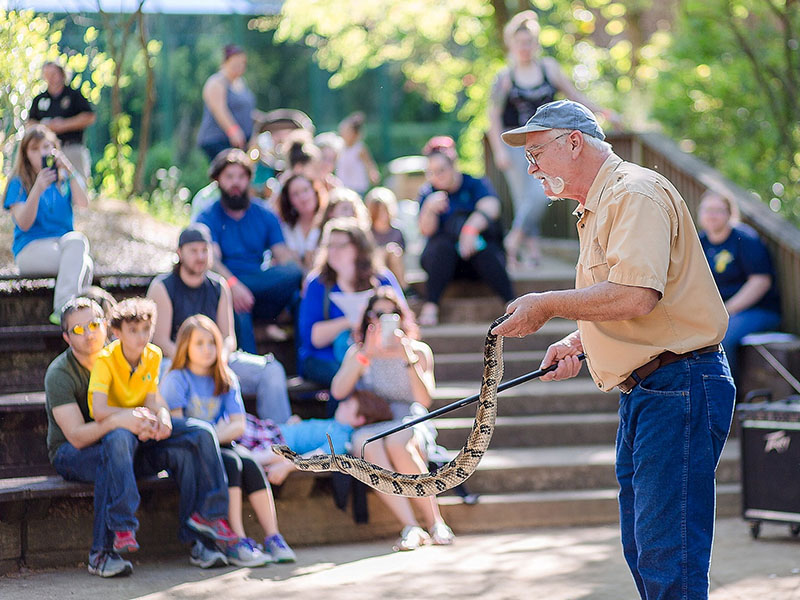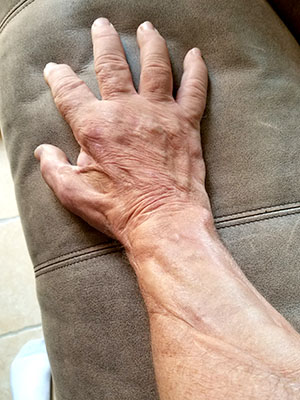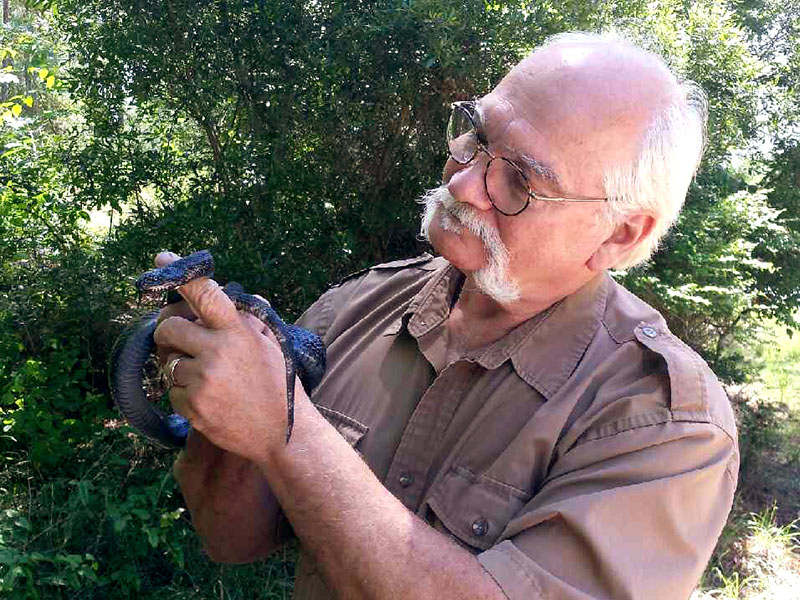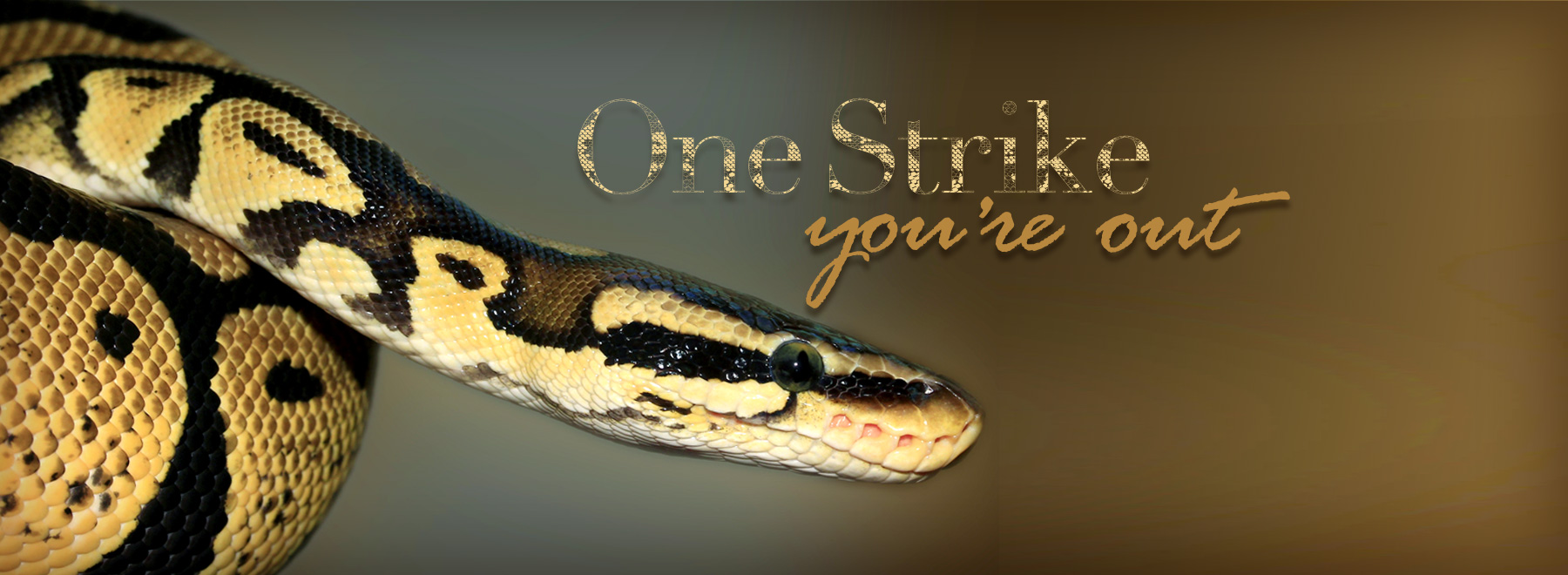Scrapes with snakes require injection of common sense
Despite his expertise and prudence, Terry “the Snake Man” Vandeventer bears a 13 ½-inch-long, 2 ½ -inch-wide scar on his right arm and hand, a 38-year-old reminder of rattlesnake bite.
“I messed up,” said Vandeventer, a herpetology field associate with the Mississippi Museum of Natural Science.
“Messing up” is among the most common reasons humans may find themselves suddenly stapled by a set of fangs; so is “being stupid.”

Since summer is the season of stupid, picnics and a spike in outdoor activities, those familiar with the habits, dangers and myths coiled around Reptilia, Serpentes are offering some limb-saving, life-saving and, potentially, life-savings savings tips.
Along with Vandeventer, one of the most experienced authorities is Dr. Bob Galli, professor of emergency medicine at the University of Mississippi Medical Center, whose car sports a personalized license plate: NVENOM8.
“That’s ‘envenomate,’” he said, “not ‘envy no mate.’”

Galli, a physician consultant with the Mississippi Poison Control Center, has furnished his office with reptilian souvenirs, including the wood-mounted skin of a copperhead who, while still alive, lit into a 72-year-old woman working in her tomato garden. The victim, who made out better than the snake, is not your typical casualty.
Galli has seen the human casualties of more than a thousand strikes over a couple of decades, he said.
In the U.S., it’s estimated that 7,000 to 8,000 people are bitten by venomous snakes each year; about five die, the National Institute for Occupational Safety and Health reports.
Most of those who die are white males, children, the elderly and victims who receive no antivenom, reports the Journal of Urgent Care Medicine.
“A snakebite is largely avoidable,” Vandeventer said. “But, make no mistake: Snakes bite people. But these instances could be greatly reduced if people would just walk away from them. Snakes don’t hate people; you are big and scary to a snake. The last thing they want is a fight with you.”
You’re most likely to see a snake between March and October. In Mississippi, roughly 100 snakebites are treated each year; 60 percent are from copperheads; 30 percent from cottonmouths; 10 percent from rattlesnakes – the most toxic of the three, Galli said.
Coral snakes are so rarely encountered in Mississippi, Galli has seen only one of their bites in 25 years. Vandeventer knows of two. Corals latch onto a victim until the venom seeps into the wound. “You can pull the snake off before that happens,” Galli said. “Of course a baby lying in the grass cannot.”
Bites are not often fatal. “If we see 2,000 snakebites in the United States, about two victims will die,” Galli said. Estimates reveal that about 20 to 25 percent of all pit viper bites are “dry” – no poison, or a minimal amount, is injected; for coral snakes alone, the estimate is 50 percent.
The severity of the injury depends on several factors, including the health and age of the victim, and the type of snake. The timing of the snake’s last meal may also be a factor; the less recent, the more toxic the bite – possibly, Galli said.
The sufferer is most likely to experience pain, swelling and possible tissue damage; other responses may include nausea, swallowing difficulties, excess saliva, breathing problems and allergic reactions.
Sometimes it’s assumed, wrongly, that victims are experiencing Compartment Syndrome – death of the muscles – although this problem almost never happens, Galli said. “At the Medical Center, we haven’t lost one digit, never mind an arm or a leg.”
You’re unlikely to mistake a venomous snakebite for anything else, not even one from a non-poisonous variety, such as a rat snake. “The rat snake’s bite is like scratches from a six-week-old kitten,” Vandeventer said.
“When a cottonmouth bites, it’s screaming, excruciating pain. It’s been described as 20 red wasp stings at one time. Like being injected with boiling oil. It takes your breath away, and it gets worse from there.”

The strike he took from the western diamondback rattlesnake in 1981, he said, “was like I had slammed my hand in a car door. Your heart is pounding in your ears.” The Jackson Zoo, where he was working at the time, no longer houses that species of snake, which, unlike the eastern diamondback, isn’t native to Mississippi, Vandeventer said.
His treating physicians did not use antivenom, also called antivenin, Vandeventer said. Instead, he endured three surgeries and 25 days in the hospital. Because of permanent nerve damage from the surgery, he cannot completely open his right hand.
Antivenom is the accepted treatment today. But the price can be equally damaging to the pocketbook, especially for the uninsured.
The average list price for what was previously the only antivenom available, CroFab, is more than $3,100 per vial, as reported by Kaiser Health News. But a suspected copperhead bite yielded a complete transportation and treatment bill exceeding $142,000 for the family of a young Illinois girl a year ago.
The sheep-derived antivenom alone, for four vials, cost nearly $68,000, says the report. That’s about $17,000 per vial.
The number of vials needed depends on the swelling. Until the swelling from a bite stops spreading, two more vials are administered with each progression. If the swelling doesn’t advance, no antivenom is necessary because “it doesn’t reverse the swelling; it only stops it,” Galli said.
A newly-arrived alternative to CroFab, called Anavip, is made from horse serum. In either case, the antivenom is universal for snakebites, Galli said.
To minimize the risks of physical and fiscal pain, keep several things in mind, Galli and Vandeventer said.
“Rock climbers should wear gloves,” Galli said. “Hikers should wear long pants, or at least thick socks. Golfers should take their five-iron everywhere on the course with them, like I do.”
Snake boots, available in stores selling outdoor gear, also work, Vandeventer said. You’re not likely to need them so much when coming foot-to-face with one of the most common types in Mississippi: the aforementioned rat snake, sometimes called a chicken snake. “Utterly harmless,” Vandeventer said.
“There’s also a little guy called a Dekay’s brown snake – found on sidewalks, in monkey grass, everywhere in the spring. Some people call it a ‘ground rattler.’ Dekay’s snake doesn’t have a rattler.” It’s also not venomous. But rattlesnakes, copperheads and cottonmouths are.

Those pit vipers display heat-sensing pits about half-way between their eyes and nostrils. Their heads are, generally speaking, broad and flat. Their pupils are vertical, like a cat’s. They exhibit a single rows of scales on the underside of their tails, compared to two rows for non-venomous snakes.
Cottonmouths are marked by a black stripe running from the nose to the back of the head and incorporating the eyes. “They look like they’re snarling,” Galli said.
The best defense against such creatures in your path is to reverse your path. “If you come upon a snake, take two steps back and walk away. No snake that ever lived in Mississippi can bite you at more than two paces,” Vandeventer said. “You’re out of the danger zone.
“Big copperheads are about 30 inches long. A rattlesnake can be about six feet. A pit viper can, generally, strike about one third of its length.”
Scarlet king snakes are not venomous, but sadly for their health, are often mistaken – by stick-, hoe- or gun-wielding avengers – for coral snakes because of similarities in coloring. Kings and corals both flaunt bands of red and black and yellow; but with corals, the reds and yellows meet; with kings, red and black touch. Remember: Red on black, venom lack; red on yellow kills a fellow.
“The king snake most recognized in Mississippi is the speckled king snake,” Vandeventer said. “It looks nothing like a coral snake.”
Coral snakes also break many of the rules used to identify the venomous snakes of North America. Their pupils are not vertical slits, they are pit-less and their heads are not broad and triangular.
More information on the appearance and habits of venomous Mississippi snakes is available at the Mississippi Department of Wildlife, Fisheries and Parks website, courtesy of Vandeventer.
If you are bitten, he said, snake-bite kits are “totally, 100 percent useless.”
As Galli put it: “The only snake-bite kit you’ll need is a set of car keys.” Drive, or have yourself driven, to the nearest hospital. Try to call ahead so the antivenom can be ready. As a resource, Galli said, the Mississippi Poison Control Center is available 24/7, at 1-800-222-1222.
Vandeventer recommends that, whenever possible, call an ambulance with your cell phone, especially out in the wild. Otherwise, if you decide to drive yourself after being bitten, “you may pass out at the wheel.” In an ambulance, he said, “treatment can begin on the way to the hospital.”
Whatever you do, do not try to kill the snake for a trophy or vengeance or the elucidation of the emergency room staff; you may be bitten again. And ER’s do not need the body for evidence; it’s unnecessary, Galli said.
Other fun herpetological facts:
- Cutting and sucking the wound doesn’t work, Galli said.
- Tourniquets can worsen the problem, said Galli, who doesn’t recommend them. “It can concentrate the toxin in one area.”
- Moth balls do not drive away snakes. They’re for moths.
- Many Mississippians call timber rattlesnakes “diamondbacks,” Vandeventer said.
Yes, snakes can strike even after they’re beheaded, as this video shows.
The above article appears in CONSULT, UMMC’s monthly e-newsletter sharing news about cutting-edge clinical and health science education advances and innovative biomedical research at the Medical Center and giving you tips and suggestions on how you and the people you love can live a healthier life. Click here and enter your email address to receive CONSULT free of charge. You may cancel at any time.



